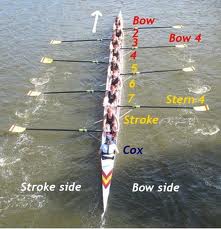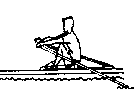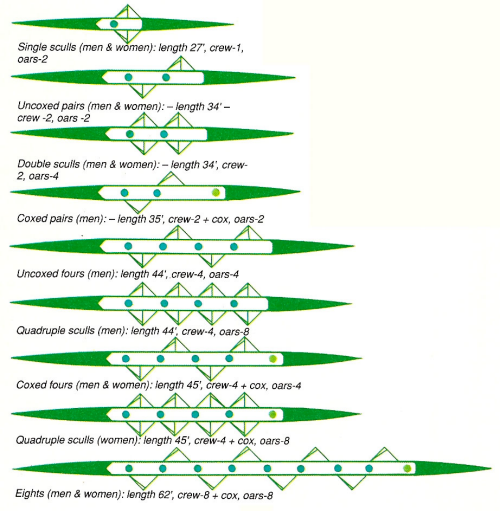| Home | History | Boats & Equipment | Techincal Aspects | Contact |
There are different types of boats
depending on how many people and what displine. To the right is a diagram
of the many different types of baots in the sport of rowing. Boats can come in
many different lengths. 60 to 62 foot long boats are Eight –oared shells, which
are about the biggest rowing boats or racing shells that are usually purchased
and raced. Rowing boats are made of carbon fiber, reinforced plastic in a
honeycombed structure and the most heaviest boats usually way about 200 pounds.
All sculls are shells, but not vice versa. The normal configuration of a sweep
boat has oars alternating between right and left, or starboard and port sides
of the boat. Sweep rowers come in pairs (2) , fours (4), and Eights(8) as
displayed in the diagram to the right. They may have a coxswain, in which case
they are called a pair with coxswain (2+), or a four with coxswain (4+). The
Coxswain is the on-the-water coach and strategist who also steers the boat.
Pairs and fours also come without coxswains (2- and 4-). The Eight always has
a coxswain (8+)
The boats (or shells) in the diagram on the right are basically of in two types and these two types of boats reflect the two forms of rowing which are sweep rowing and sculling. In sweep rowing each rower handles a single oar (about 12.5 ft or 3.9 m long).In sculling a rower uses two oars, or sculls, (each about 9.5 ft or 3 m long). The word shell is often used in reference to the boats used because the hull is only about 1/8" to 1/4" thick to make it as light as possible. These shells are also rather long and as narrow as possible, which makes the boats very fast, but also quite hard to 'sit.
 Inside a Rowing Boat
Inside a Rowing Boat
Each
rower sits on a sliding seat that rolls on wheels along a fixed track called
the slide . Feet are tied into shoes which are bolted onto footplate's in the
boat. Each oar is held in place by riggers , which extend from the saxboard .
The rigger holds the oar lock in which the oar sits. The oar lock is carefully
set up so that the oar is held in the water with a specific amount of pitch or
tilt. This is usually about 5 degrees at the midpoint of the stroke although it
can change through the stroke, depending how it is set up.
The
footplate and stretcher is a fixture in a boat that contains shoes screwed into
a piece of carbon or metal. This equipment holds the rower's feet into the boat
and is the only part of the boat where the rower is firmly attached. The shoes
have quick release velcro straps, but should not be over tightened as you may
need to release your feet in the event of a capsize. The position of the feet
is adjustable to accommodate different height rowers, give yourself plenty of
room. This is achieved by loosening the three wing nuts securing the stretcher
to the tracks and then lifting and sliding the footplate to the required
position. If you are rowing in the same boat regularly, it is a good idea to
remember the position of the shoes so that you can adjust the boat before you
get in.
The saxboard is the top side of the boat - the edges onto which the riggers are bolted. The oar lock is a small plastic part at the end of the rigger that opens at the top. The rower opens the oar lock, places the oar into it, then shuts the top metal bar, screwing it tightly shut. The oar lock holds the oar in place during the rowing stroke. The rigger is the piece of metal support attached to the saxboard that holds the oar lock, these can be either wing or gull riggers, The slides are tracks underneath each seat which the wheels of the seat slide on, allowing the rower to move back and forth in the boat, utilizing their full leg power, it is important to keep these well maintained throughout the year. The Oar Lock is referred to as the Gate in the diagram above and to the right.

The Rowing Oar
The picture or diagram above is of a sculling Oar that is used in Rowing to move boats through the water and act as balancers. There are two types of Oars, which are sweep oars and Sculling oars. Sweep oars are 12 to 13 feet long and are approximately two feet longer than sculling oars.The Standard blade shape since the 90's is a hatchet. For more information on the history of the oar, reference the history page.The Diagram above shows the handle at the end of the oar where a rowers hands are placed while they are in the boat and rowing. On a sweep oar, you will have two places to grab the oar and on a sculling oar you will have one place to grab the oars as you will need two pars for the art of sculling as a dsipline in Rowing. The Button or Collar is a critical part of the oar because it is what stops oars from going through the oar lock when pressure is exerted on the oar. The sleeve is the part of the oar shaped perfectly for the oar lock, so that the oar can be twisted when a rower needs to feather the oar. Feathering is done to reduce wind resistance on the oar. The blade is critical to the oar because this is where a rower grabs and sends a boat past the point of insertion at the catch. The Loom is everything from the blade to the Handle.
The Ergometer


The Ergometer is a rowing machine used mostly indoors for training in the winter months. Often used to test athletes in the sport of rowing for placement into a specific boat. Ergometers can be used outside and at regattas giving athletes an alternative way to warm up before a race out on a body of water. Ergometers have monitors which calculate a rowers time per a 500 meters, which is called split time and this allows a rower to see how hard they are pulling, how long it took them to finish a set workout like 2000 meters, and what rate of strokes they were taking during their workout.
Picture below is a link to the vocabulary in the Sport of Rowing.


